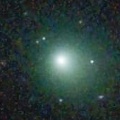
|
It brightened rapidly. Now it is very bright as 10.5 mag (May 31, Chris Wyatt). It stays observable at 11 mag in good condition for a long time from spring to summer.
Date(TT) R.A. (2000) Decl. Delta r Elong. m1 Best Time(A, h)
June 5 13 36.75 21 32.9 1.456 2.100 115 11.0 20:55 ( 14, 76)
June 12 13 38.77 18 35.6 1.484 2.084 111 11.0 21:00 ( 34, 70)
|

|
Now it is very bright as 9.7 mag (June 4, Michael Jager). It stays bright as 10-12 mag until August. In the Southern Hemisphere, it stays observable in excellent condition for a long time. In the Northern Hemisphere, it stays observable in good condition for a while. But it becomes extremely low after July.
Date(TT) R.A. (2000) Decl. Delta r Elong. m1 Best Time(A, h)
June 5 21 48.08 -14 7.6 0.446 1.239 109 11.5 3:01 (326, 34)
June 12 22 15.07 -19 1.7 0.442 1.250 111 11.4 2:59 (328, 30)
|
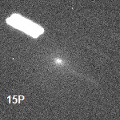
|
Now it is very bright as 12.5 mag (May 18, Thomas Lehmann). It will brighten very rapidly, and it will brighten up to 10 mag from July to August. It stays observable in the morning sky for a long time.
Date(TT) R.A. (2000) Decl. Delta r Elong. m1 Best Time(A, h)
June 5 0 45.53 -1 32.1 1.108 1.136 64 13.0 3:01 (281, 13)
June 12 1 17.37 2 29.2 1.091 1.092 62 12.4 2:59 (277, 14)
|

|
Now it is 12.5 mag (May 23, Thomas Lehmann). It will brighten up to 10 mag in winter in 2022. In the Northern Hemisphere, it stays observable in good condition for a long time, although it becomes extremely low temporarily from May to June. In the Southern Hemisphere, it is not observable until November.
Date(TT) R.A. (2000) Decl. Delta r Elong. m1 Best Time(A, h)
June 5 4 24.71 50 8.8 4.931 4.065 28 12.5 3:01 (211, 7)
June 12 4 38.33 49 57.6 4.903 4.035 28 12.4 2:59 (212, 8)
|
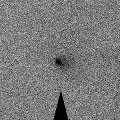
|
Now it is 11 mag (May 12, Giuseppe Pappa). In the Southern Hemisphere, it is observable in the morning sky. In the Northern Hemisphere, it will appear in the morning sky in June.
Date(TT) R.A. (2000) Decl. Delta r Elong. m1 Best Time(A, h)
June 5 1 58.40 3 26.1 2.129 1.602 46 12.5 3:01 (267, 1)
June 12 2 15.68 4 31.6 2.125 1.636 48 12.7 2:59 (267, 3)
|
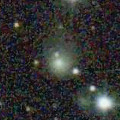
|
Now it is 13.5 mag (May 24, Thomas Lehmann). It is expected to be observable at 5-6 mag for a long time from 2022 to 2023. In the Northern Hemisphere, it is not observable at the high light from 2022 summer to 2023 summer. In the Southern Hemisphere, it stays extremely low for a while. But it will be observable in good condition at the high light.
Date(TT) R.A. (2000) Decl. Delta r Elong. m1 Best Time(A, h)
June 5 17 57.26 43 34.4 5.743 6.199 112 12.7 1:04 (180, 81)
June 12 17 50.95 43 30.9 5.673 6.141 112 12.7 0:31 (180, 81)
|

|
Now it is 14.4 mag (May 18, Thomas Lehmann). It will brighten up to 10 mag from summer to autumn, and it will be observable in excellent condition. Appearing in the morning sky.
Date(TT) R.A. (2000) Decl. Delta r Elong. m1 Best Time(A, h)
June 5 0 52.49 8 47.0 2.198 1.885 58 13.0 3:01 (272, 18)
June 12 1 9.44 10 12.4 2.114 1.851 61 12.7 2:59 (271, 20)
|
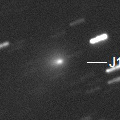
|
Now it is bright as 12.5 mag (May 30, Michael Jager). It stays 13 mag until early summer. In the Southern Hemisphere, it stays observable in good condition for a long time. It locates somewhat low in the Northern Hemisphere.
Date(TT) R.A. (2000) Decl. Delta r Elong. m1 Best Time(A, h)
June 5 14 37.26 -22 0.2 2.475 3.385 148 13.1 21:40 ( 0, 33)
June 12 14 23.88 -19 25.2 2.563 3.394 138 13.2 21:00 ( 0, 36)
|
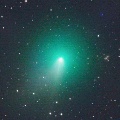
|
It brightened up to 8.9 mag in April (Apr. 12, Carlos Labordena). Now it is fading. But it is still bright as 12.4 mag (May 17, Chris Wyatt). It will be fading and getting lower rapidly after this. It will be unobservable at 17 mag in July.
Date(TT) R.A. (2000) Decl. Delta r Elong. m1 Best Time(A, h)
June 5 11 0.83 20 54.3 1.618 1.819 84 13.4 20:55 ( 81, 50)
June 12 10 56.57 19 29.3 1.850 1.902 77 14.0 21:00 ( 85, 42)
|
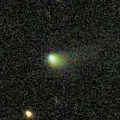
|
Now it is 13.9 mag (May 13, Taras Prystavski). It stays 13-14 mag from 2020 to 2021. It will be observable in good condition after this in the Southern Hemisphere. It locates somewhat low in the Northern Hemisphere.
Date(TT) R.A. (2000) Decl. Delta r Elong. m1 Best Time(A, h)
June 5 19 27.83 -29 36.5 2.031 2.917 144 13.6 2:35 ( 0, 25)
June 12 19 24.86 -30 28.8 1.992 2.924 151 13.6 2:05 ( 0, 25)
|
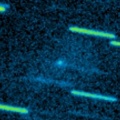
|
Now it is 16.8 mag (May 28, Jean-Francois Soulier). Brightening very rapidly. It will brighten up to 8.5 mag from September to October. But the condition is bad in this apparition. In the Northern Hemisphere, it is observable only in the extremely low sky until July. In the Southern Hemisphere, it will be observable after late August. But it stays locating low for a while.
Date(TT) R.A. (2000) Decl. Delta r Elong. m1 Best Time(A, h)
June 5 3 43.22 44 38.6 2.436 1.590 26 14.3 3:01 (220, 8)
June 12 4 10.85 43 42.8 2.377 1.520 25 13.9 2:59 (220, 7)
|
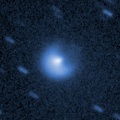
|
Now it is not observable. It will appear in the morning sky in July.
Date(TT) R.A. (2000) Decl. Delta r Elong. m1 Best Time(A, h)
June 5 3 50.14 27 57.9 6.860 5.885 14 14.0 3:01 (231, -5)
June 12 3 56.23 28 16.0 6.833 5.887 19 13.9 2:59 (233, -1)
|
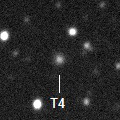
|
Now it is 14.3 mag (May 31, Chris Wyatt). It is expected to brighten up to 11.5 mag in 2022. It is observable in excellent condition in the Southern Hemisphere. In the Northern Hemisphere, it is not observable until November.
Date(TT) R.A. (2000) Decl. Delta r Elong. m1 Best Time(A, h)
June 5 8 36.04 -25 0.2 5.426 5.207 72 14.1 20:55 ( 63, -6)
June 12 8 42.31 -24 23.3 5.466 5.175 68 14.0 21:00 ( 67,-10)
|
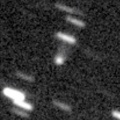
|
Now it is 14.8 mag (May 31, Chris Wyatt). It was expected to brighten up to 13 mag from spring to summer. But actually, it is fainter than originally expected. It stays 14-15 mag until early autumn. In the Southern Hemisphere, it stays observable in good condition for a long time. In the Northern Hemisphere, it is not observable until July in 2022.
Date(TT) R.A. (2000) Decl. Delta r Elong. m1 Best Time(A, h)
June 5 22 10.39 -81 12.1 3.068 3.599 113 14.5 3:01 (354,-27)
June 12 22 35.27 -82 22.5 3.056 3.597 114 14.5 2:59 (355,-28)
|
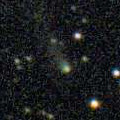
|
Now it is 14.8 mag (June 3, Michael Jager). It will stay at 14-15 mag for a long time from 2021 to 2022. It stays observable in good condition after this while brightening gradually.
Date(TT) R.A. (2000) Decl. Delta r Elong. m1 Best Time(A, h)
June 5 17 34.53 -2 4.5 4.177 5.126 157 14.7 0:42 ( 0, 53)
June 12 17 26.48 -2 52.1 4.150 5.114 159 14.7 0:07 ( 0, 52)
|

|
It will brighten up to 14.5 mag from spring to summer. In the Southern Hemisphere, it stays observable in excellent condition for a long time. In the Northern Hemisphere, it is not observable after this.
Date(TT) R.A. (2000) Decl. Delta r Elong. m1 Best Time(A, h)
June 5 3 31.09 -66 58.7 2.474 2.686 90 14.7 3:01 (331,-41)
June 12 4 22.71 -68 14.5 2.466 2.700 91 14.7 2:59 (334,-43)
|

|
Now it is 14.8 mag (May 22, Thomas Lehmann). It stays 14-15 mag until the end of 2021. In the Southern Hemisphere, it stays observable in good condition for a long time. In the Northern Hemisphere, it is not observable until June.
Date(TT) R.A. (2000) Decl. Delta r Elong. m1 Best Time(A, h)
June 5 23 40.92 -35 7.6 4.188 4.368 93 14.8 3:01 (317, 2)
June 12 23 42.68 -34 51.0 4.105 4.376 98 14.8 2:59 (320, 6)
|

|
It brightened up to 11.6 mag in winter (Feb. 18, Thomas Lehmann). Now it is fading. It has already faded down to 14.2 mag (May 11, Thomas Lehmann). In the Southern Hemisphere, it stays observable in good condition after this. In the Northern Hemisphere, it will never be observable after this.
Date(TT) R.A. (2000) Decl. Delta r Elong. m1 Best Time(A, h)
June 5 4 56.93 -52 48.7 2.948 2.865 75 14.8 20:55 ( 47,-53)
June 12 5 3.21 -52 33.4 3.008 2.929 75 14.9 2:59 (313,-51)
|
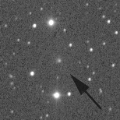
|
Now it is 14.5 mag (May 21, Thomas Lehmann). It stays 15 mag until summer. In the Southern Hemisphere, it stays observable in good condition until June. In the Northern Hemisphere, it is observable in the low sky from March to May.
Date(TT) R.A. (2000) Decl. Delta r Elong. m1 Best Time(A, h)
June 5 8 9.74 0 39.8 2.474 2.029 52 15.0 20:55 ( 88, 4)
June 12 8 22.72 3 9.7 2.537 2.010 48 15.1 21:00 ( 93, 2)
|

|
It brightened up to 10.5 mag in early March (Mar. 8, Bob King). Now it is fading. It has already faded down to 18.1 mag (May 11, Slooh.com Canary Islands Observatory). In the Northern Hemisphere, it stays observable in the evening low sky until early June while the comet will be fading. It is not observable in the Southern Hemisphere.
Date(TT) R.A. (2000) Decl. Delta r Elong. m1 Best Time(A, h)
June 5 6 55.22 28 40.0 2.669 1.841 28 15.3 20:55 (121, 6)
June 12 7 13.66 27 18.5 2.793 1.930 25 15.6 21:00 (122, 3)
|

|
Now it is 15.2 mag (May 31, Chris Wyatt). It will brighten up to 13 mag in 2022. In 2021, it is observable at 14-15 mag in good condition.
Date(TT) R.A. (2000) Decl. Delta r Elong. m1 Best Time(A, h)
June 5 12 58.77 -0 25.6 2.957 3.565 119 15.3 20:55 ( 22, 52)
June 12 12 58.75 -0 46.1 3.031 3.550 112 15.3 21:00 ( 34, 49)
|
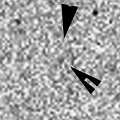
|
Now it is 15.4 mag (May 30, Hirohisa Sato). It will brighten up to 14 mag in summer, and it will be observable in excellent condition. It locates somewhat low in the Southern Hemisphere.
Date(TT) R.A. (2000) Decl. Delta r Elong. m1 Best Time(A, h)
June 5 21 42.88 15 34.4 2.242 2.605 99 15.6 3:01 (302, 59)
June 12 21 30.41 18 26.0 2.095 2.571 106 15.3 2:59 (312, 67)
|
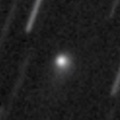
|
Now it is 15.7 mag (May 29, Michael Jager). In the Northern Hemisphere, it stays observable at 15-16 mag for a long time from spring to early 2022. In the Southern Hemisphere, it is not observable until the end of 2021.
Date(TT) R.A. (2000) Decl. Delta r Elong. m1 Best Time(A, h)
June 5 13 51.26 77 18.6 3.169 3.097 76 15.4 20:55 (180, 48)
June 12 13 13.24 74 20.1 3.186 3.081 74 15.3 21:00 (172, 50)
|

|
It has not been observed yet in this apparition. The condition of this apparition is bad. It brightens up to 15.5 mag in spring, however, it is not observable until autumn when it becomes fainter than 19 mag.
Date(TT) R.A. (2000) Decl. Delta r Elong. m1 Best Time(A, h)
June 5 4 40.02 24 36.0 2.234 1.223 3 15.6 3:01 (225,-15)
June 12 5 8.68 25 33.4 2.246 1.234 3 15.6 2:59 (224,-14)
|

|
Now it is 15.4 mag (Apr. 19, Toshihiko Ikemura, Hirohisa Sato). In the Northern Hemisphere, it stays observable for a long time while it is getting fainter slowly. In the Southern Hemisphere, it will never be observable again.
Date(TT) R.A. (2000) Decl. Delta r Elong. m1 Best Time(A, h)
June 5 13 47.21 64 38.4 6.007 6.019 85 15.7 20:55 (179, 61)
June 12 13 41.03 63 22.2 6.099 6.068 83 15.8 21:00 (170, 61)
|
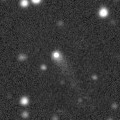
|
Now it is 16.0 mag (May 10, Michael Jager). It stays observable at 16 mag from 2021 to 2022. Toshihiko Ikemura and Hirohisa Sato reported it was very bright as 14.2 mag on Apr. 19.
Date(TT) R.A. (2000) Decl. Delta r Elong. m1 Best Time(A, h)
June 5 13 41.13 -5 0.1 4.070 4.795 130 15.8 20:55 ( 4, 50)
June 12 13 39.26 -3 49.0 4.152 4.785 123 15.8 21:00 ( 17, 50)
|

|
Now it is 15.8 mag (May 29, Hiroshi Abe). Toshihiko Ikemura and Hirohisa Sato reported it was bright as 14.7 mag on Apr. 18. It is expected to brighten up to 13 mag in 2022. In the Southern Hemisphere, it stays observable in good condition for a long time. In the Northern Hemisphere, it stays observable until June, but it will not be observable at the high light.
Date(TT) R.A. (2000) Decl. Delta r Elong. m1 Best Time(A, h)
June 5 12 16.11 -20 25.4 4.166 4.706 116 15.8 20:55 ( 26, 30)
June 12 12 11.44 -20 23.3 4.230 4.661 109 15.8 21:00 ( 35, 26)
|
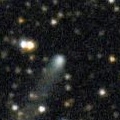
|
Now it is 16.2 mag (May 24, Thomas Lehmann). It stays 15-16 mag until July. In the Northern Hemisphere, it stays observable in good condition for a long time. It is not observable after this in the Southern Hemisphere.
Date(TT) R.A. (2000) Decl. Delta r Elong. m1 Best Time(A, h)
June 5 18 20.73 55 45.0 5.030 5.293 99 16.0 1:28 (180, 69)
June 12 18 7.94 56 39.5 5.058 5.322 99 16.0 0:48 (180, 68)
|

|
It had been observed as 8-9 mag for a long time in 2020. Now it is fading. It has already faded down to 17.0 mag (May 25, ATLAS-MLO, Mauna Loa). It will be observable in good condition after this in the Southern Hemisphere. It locates extremely low after this in the Northern Hemisphere.
Date(TT) R.A. (2000) Decl. Delta r Elong. m1 Best Time(A, h)
June 5 16 54.28 -46 9.9 3.882 4.829 156 16.0 0:03 ( 0, 9)
June 12 16 46.13 -46 26.2 3.949 4.892 155 16.1 23:22 ( 0, 9)
|

|
Now it is 16.6 mag (May 30, ATLAS-MLO, Mauna Loa). It will brighten up to 9 mag, and will be observable in good condition in winter.
Date(TT) R.A. (2000) Decl. Delta r Elong. m1 Best Time(A, h)
June 5 23 41.23 -6 14.6 1.992 2.091 81 16.3 3:01 (296, 23)
June 12 23 53.96 -4 58.4 1.867 2.035 84 16.0 2:59 (297, 26)
|

|
Now it is 15.1 mag (May 24, Mike Olason). Appearing in the morning sky. In the Northern Hemisphere, it stays observable in good condition while the comet will be fading. In the Southern Hemipsphere, it stays locating extremely low after this.
Date(TT) R.A. (2000) Decl. Delta r Elong. m1 Best Time(A, h)
June 5 2 26.43 27 43.6 3.011 2.232 33 16.1 3:01 (243, 10)
June 12 2 41.04 29 17.2 2.990 2.252 36 16.2 2:59 (243, 12)
|
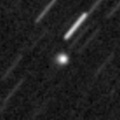
|
Now it is 16.2 mag (May 9, Toshihiko Ikemura, Hirohisa Sato). It is expected to brighten up to 11 mag in 2023. In the Northern Hemisphere, it stays observable in good condition for a long time. It locates extremely low in the Southern Hemisphere.
Date(TT) R.A. (2000) Decl. Delta r Elong. m1 Best Time(A, h)
June 5 17 38.44 50 49.2 6.305 6.656 105 16.3 0:46 (180, 74)
June 12 17 28.88 50 57.8 6.261 6.611 105 16.3 0:09 (180, 74)
|
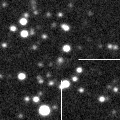
|
Now it is 16.3 mag (May 30, ATLAS-HKO, Haleakala). It stays at 16-17 mag from 2020 to 2021. In the Northern Hemisphere, it stays observable in good condition for a long time. It locates extremely low in the Southern Hemisphere.
Date(TT) R.A. (2000) Decl. Delta r Elong. m1 Best Time(A, h)
June 5 19 30.97 48 30.0 8.592 8.835 100 16.3 2:38 (180, 76)
June 12 19 26.48 49 14.9 8.563 8.837 102 16.3 2:06 (180, 76)
|
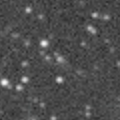
|
Now it is 15.7 mag (May 30, W. Hasubick). It stays observable at 16-17 mag in good condition until October.
Date(TT) R.A. (2000) Decl. Delta r Elong. m1 Best Time(A, h)
June 5 17 3.84 -23 34.5 3.893 4.907 177 16.4 0:12 ( 0, 31)
June 12 16 58.29 -22 22.1 3.888 4.900 174 16.4 23:34 ( 0, 33)
|

|
Now it is 16.6 mag (May 24, ATLAS-MLO, Mauna Loa). It is observable at 16 mag from 2020 to 2021. In the Southern Hemisphere, it is not observable until summer.
Date(TT) R.A. (2000) Decl. Delta r Elong. m1 Best Time(A, h)
June 5 23 18.75 44 30.2 6.258 5.983 69 16.4 3:01 (240, 50)
June 12 23 17.30 44 45.6 6.180 5.989 74 16.4 2:59 (240, 55)
|
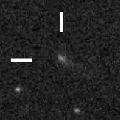
|
Now it is 16.4 mag (May 23, Slooh.com Chile Observatory, La Dehesa). It will brighten up to 15 mag from summer to autumn. In the Southern Hemisphere, it stays observable for a long time. In the Northern Hemisphere, it is not observable until late June. But it will be observable in good condition after that.
Date(TT) R.A. (2000) Decl. Delta r Elong. m1 Best Time(A, h)
June 5 1 53.46 -1 2.0 2.198 1.719 49 16.7 3:01 (271, 0)
June 12 2 11.08 1 8.9 2.132 1.688 50 16.4 2:59 (270, 2)
|
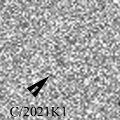
|
Now it is 16.2 mag (May 30, ATLAS-MLO, Mauna Loa). It stays 16.5 mag until August and stays observable in good condition.
Date(TT) R.A. (2000) Decl. Delta r Elong. m1 Best Time(A, h)
June 5 23 59.89 -4 24.5 2.560 2.517 76 16.5 3:01 (291, 20)
June 12 0 10.46 -4 5.3 2.491 2.526 80 16.4 2:59 (293, 23)
|

|
Now it is 15.9 mag (May 31, ATLAS-HKO, Haleakala). It is observable at 16.5 mag from spring in 2020 to summer in 2021.
Date(TT) R.A. (2000) Decl. Delta r Elong. m1 Best Time(A, h)
June 5 16 22.02 -17 53.0 3.924 4.930 171 16.5 23:25 ( 0, 37)
June 12 16 11.68 -18 19.9 3.969 4.950 163 16.5 22:47 ( 0, 37)
|
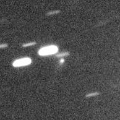
|
Now it is 17.4 mag (May 29, Michael Jager). It will approach to Earth down to 0.2 a.u. in December, and it is expected to brighten up to 4 mag. In the Northern Hemisphere, it stays observable in good condition for a long time until December while the comet is brightening gradually. In the Southern Hemisphere, it is not observable until mid December. Actually, it is somewhat fainter than this ephemeris recently.
Date(TT) R.A. (2000) Decl. Delta r Elong. m1 Best Time(A, h)
June 5 10 37.85 56 26.8 3.627 3.407 69 16.6 20:55 (138, 51)
June 12 10 33.18 55 9.2 3.631 3.323 64 16.5 21:00 (136, 46)
|

|
It brightened up to 3 mag in December in the SOHO spacecraft images (Dec. 18, Hirohisa Sato). Now it is 15 mag (May 20, Mike Olason). It stays observable in good condition after this while the comet will be fading.
Date(TT) R.A. (2000) Decl. Delta r Elong. m1 Best Time(A, h)
June 5 0 15.36 17 8.0 3.372 3.078 64 16.5 3:01 (269, 30)
June 12 0 18.19 17 48.2 3.362 3.167 70 16.6 2:59 (272, 35)
|

|
Now it is 18.6 mag (May 14, Mt. Lemmon Survey). It is expected to brighten up to 15 mag from summer to autumn, and it will be observable in good condition. However, it is fainter than this ephemeris recently.
Date(TT) R.A. (2000) Decl. Delta r Elong. m1 Best Time(A, h)
June 5 22 41.53 -5 49.0 2.092 2.396 94 16.7 3:01 (307, 33)
June 12 22 49.62 -5 27.5 1.999 2.383 99 16.5 2:59 (311, 36)
|
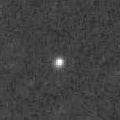
|
Now it is 16.8 mag (May 29, Michael Jager). It is expected to brighten up to 10 mag in 2023. In the Northern Hemisphere, it stays observable in good condition until 2023 autumn. In the Southern Hemipshere, it stays extremely low until mid July, then it becomes unobservable for a while. But it becomes observable in good condition after 2023 summer.
Date(TT) R.A. (2000) Decl. Delta r Elong. m1 Best Time(A, h)
June 5 12 5.87 38 40.8 7.069 7.132 89 16.8 20:55 (107, 69)
June 12 12 3.75 38 26.4 7.118 7.079 83 16.8 21:00 (107, 62)
|
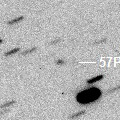
|
Now it is 18.1 mag (June 2, Michael Jager). It will brighten up to 15.5 mag from summer to autumn. It stays observable for a long time.
Date(TT) R.A. (2000) Decl. Delta r Elong. m1 Best Time(A, h)
June 5 15 14.49 -13 40.2 1.133 2.098 155 17.0 22:18 ( 0, 41)
June 12 15 10.14 -13 18.7 1.135 2.065 147 16.8 21:46 ( 0, 42)
|
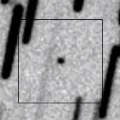
|
Now it is 17.3 mag (May 18, Ager). It will brighten very rapidly, and it will be observable at 10 mag in good condition from October to December. In the Northern Hemisphere, it locates somewhat low at the high light.
Date(TT) R.A. (2000) Decl. Delta r Elong. m1 Best Time(A, h)
June 5 16 33.36 17 50.3 0.886 1.783 139 17.0 23:36 ( 0, 73)
June 12 16 27.12 17 47.0 0.850 1.737 137 16.8 23:03 ( 0, 73)
|

|
It will brighten up to 12.5 mag in 2022 summer. In the Southern Hemisphere, it stays observable in excellent condition for a long time. In the Northern Hemisphere, it is not observable until August in 2022.
Date(TT) R.A. (2000) Decl. Delta r Elong. m1 Best Time(A, h)
June 5 3 27.36 -43 19.1 5.569 5.285 68 17.0 3:01 (301,-39)
June 12 3 31.93 -43 59.9 5.466 5.235 71 16.9 2:59 (303,-36)
|
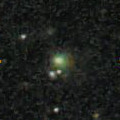
|
It brightened rapidly up to 15.5 mag in April (Apr. 5, Sandor Szabo). Now it is fading. It has already fade down to 17.3 mag (May 30, ATLAS-MLO, Mauna Loa). It will be fainter than 18 mag in July.
Date(TT) R.A. (2000) Decl. Delta r Elong. m1 Best Time(A, h)
June 5 11 58.92 -1 6.6 1.960 2.442 105 16.9 20:55 ( 42, 45)
June 12 11 49.53 -3 1.2 2.109 2.462 97 17.2 21:00 ( 52, 37)
|

|
Now it is 16.8 mag (May 24, ATLAS-HKO, Haleakala). It will be fading slowly.
Date(TT) R.A. (2000) Decl. Delta r Elong. m1 Best Time(A, h)
June 5 17 46.58 -13 42.2 6.697 7.678 164 17.0 0:54 ( 0, 41)
June 12 17 40.89 -13 21.3 6.704 7.703 169 17.1 0:21 ( 0, 42)
|
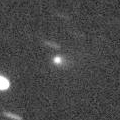
|
First return of a new periodic comet which brightened up to 16 mag in 2014. Now it is 16.7 mag (May 28, ATLAS-HKO, Haleakala). It stays observable at 16-17 mag in good condition until July.
Date(TT) R.A. (2000) Decl. Delta r Elong. m1 Best Time(A, h)
June 5 12 14.11 2 45.4 1.630 2.168 107 17.1 20:55 ( 40, 51)
June 12 12 18.52 1 7.8 1.694 2.160 102 17.2 21:00 ( 47, 45)
|
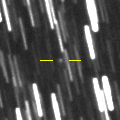
|
Now it is 17.3 mag (May 30, ATLAS-HKO, Haleakala). It will brighten up to 15.5 mag in winter. In the Northern Hemisphere, it stays observable in good condition for a long time. It is not observable at all in the Southern Hemisphere.
Date(TT) R.A. (2000) Decl. Delta r Elong. m1 Best Time(A, h)
June 5 21 5.21 59 27.5 3.778 3.793 83 17.4 3:01 (200, 63)
June 12 20 58.79 62 7.9 3.712 3.752 84 17.3 2:59 (190, 62)
|

|
First return of a new periodic comet observed at 17 mag in 2014. It has not been observed yet in this apparition. It is expected to brighten up to 17 mag from summer to autumn, and it will be observable in good condition.
Date(TT) R.A. (2000) Decl. Delta r Elong. m1 Best Time(A, h)
June 5 0 4.22 4 52.2 1.701 1.680 71 17.4 3:01 (282, 25)
June 12 0 19.93 7 14.5 1.651 1.676 73 17.3 2:59 (282, 29)
|
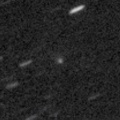
|
Now it is 18.6 mag (May 30, W. Hasubick). It will be observable at 11 mag from winter to spring in 2022. In 2021, it is observable until July or August when it brightens up to 16-17 mag.
Date(TT) R.A. (2000) Decl. Delta r Elong. m1 Best Time(A, h)
June 5 10 31.36 13 24.3 2.931 2.935 80 17.5 20:55 ( 77, 40)
June 12 10 36.50 12 50.2 2.987 2.895 74 17.4 21:00 ( 81, 34)
|
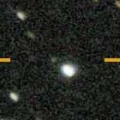
|
Now it is 17.2 mag (May 26, ATLAS-HKO, Haleakala). It is expected to brighten up to 12 mag in 2023. In the Northern Hemisphere, it is observable in good condition in 2021. But it is observable only until November in 2022. In the Southern Hemisphere, it locates extremely low in 2021. But it will be observable in good condition at the high light.
Date(TT) R.A. (2000) Decl. Delta r Elong. m1 Best Time(A, h)
June 5 18 24.57 46 32.9 6.547 6.925 107 17.5 1:32 (180, 78)
June 12 18 18.93 46 30.9 6.477 6.877 109 17.4 0:58 (180, 78)
|
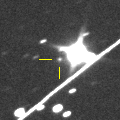
|
Now it is 17.3 mag (May 3, Michael Jager). It stays observable at 17-18 mag for a long time until 2024.
Date(TT) R.A. (2000) Decl. Delta r Elong. m1 Best Time(A, h)
June 5 14 42.37 -7 9.2 8.273 9.125 145 17.5 21:46 ( 0, 48)
June 12 14 38.47 -6 48.9 8.338 9.115 137 17.5 21:15 ( 0, 48)
|
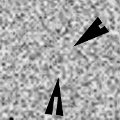
|
Now it is 18.8 mag (May 18, ATLAS-MLO, Mauna Loa). It will brighten up to 15-16 mag in autumn and it will be observable in good condition.
Date(TT) R.A. (2000) Decl. Delta r Elong. m1 Best Time(A, h)
June 5 22 58.66 -11 14.5 1.958 2.247 92 17.8 3:01 (308, 27)
June 12 23 6.93 -10 2.6 1.870 2.235 97 17.6 2:59 (311, 30)
|

|
Now it is 17.7 mag (May 12, ATLAS-HKO, Haleakala). It brightened rapidly. It stays 17-18 mag for a long time from 2021 to 2022. In the Southern Hemisphere, it stays observable in good condition for a long time. In the Northern Hemisphere, it is observable only until May.
Date(TT) R.A. (2000) Decl. Delta r Elong. m1 Best Time(A, h)
June 5 8 19.22 -8 38.9 5.909 5.465 59 17.6 20:55 ( 79, 1)
June 12 8 21.17 -9 2.5 5.979 5.454 54 17.6 21:00 ( 83, -6)
|

|
It has not been observed yet in this apparition. It will brighten rapidly up to 15 mag in autumn. It will be observable in excellent condition in the Northern Hemisphere. It locates somewhat low in the Southern Hemisphere.
Date(TT) R.A. (2000) Decl. Delta r Elong. m1 Best Time(A, h)
June 5 1 27.06 0 43.0 2.316 1.910 54 17.8 3:01 (273, 6)
June 12 1 43.00 2 27.4 2.236 1.878 56 17.6 2:59 (273, 9)
|
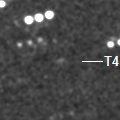
|
In the Northern Hemisphere, it is observable at 17-18 mag from spring to autumn. It is not observable in the Southern Hemisphere.
Date(TT) R.A. (2000) Decl. Delta r Elong. m1 Best Time(A, h)
June 5 3 27.02 67 26.1 2.787 2.220 46 17.7 3:01 (203, 24)
June 12 3 54.27 70 35.7 2.735 2.209 49 17.6 2:59 (200, 26)
|
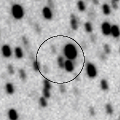
|
Now it is 17.5 mag (May 29, R. Naves, M. Campas). It is expected to brighten up to 11 mag from spring to summer in 2022. In the Southen Hemisphere, it locates somewhat low in 2021, but it will be observable in good condition at the high light for a long time. In the Northern Hemisphere, it is observable in good condition in 2021, but it will not be observable at the high light.
Date(TT) R.A. (2000) Decl. Delta r Elong. m1 Best Time(A, h)
June 5 20 50.25 37 26.1 4.319 4.571 97 17.8 3:01 (253, 78)
June 12 20 44.91 37 50.3 4.179 4.508 102 17.6 2:59 (239, 84)
|

|
Now it is 17.5 mag (May 30, ATLAS-MLO, Mauna Loa). It will brighten up to 16 mag in 2022. In 2021, it stays observable at 18 mag until September.
Date(TT) R.A. (2000) Decl. Delta r Elong. m1 Best Time(A, h)
June 5 13 19.28 3 9.4 2.661 3.314 122 17.7 20:55 ( 15, 57)
June 12 13 19.22 2 40.6 2.730 3.302 115 17.7 21:00 ( 28, 54)
|

|
It brightened up to 13.8 mag in autumn in 2019 (Sept. 3, 2019, Chris Wyatt). Now it is fading slowly. It stays 18 mag until autumn.
Date(TT) R.A. (2000) Decl. Delta r Elong. m1 Best Time(A, h)
June 5 0 46.04 17 12.2 8.358 7.861 57 17.8 3:01 (265, 24)
June 12 0 47.57 17 46.2 8.303 7.904 63 17.8 2:59 (267, 29)
|

|
Now it is 17.3 mag (May 24, ATLAS-HKO, Haleakala). It stays 17-18 mag for a long time from 2021 to 2023.
Date(TT) R.A. (2000) Decl. Delta r Elong. m1 Best Time(A, h)
June 5 10 44.18 10 53.0 4.847 4.850 84 17.8 20:55 ( 72, 41)
June 12 10 47.31 10 27.8 4.946 4.843 78 17.9 21:00 ( 77, 35)
|

|
Now it is 17.7 mag (May 10, ATLAS-MLO, Mauna Loa). Fading slowly. In 2021, it stays observable at 17-18 mag in good condition until early summer.
Date(TT) R.A. (2000) Decl. Delta r Elong. m1 Best Time(A, h)
June 5 12 54.68 -12 41.0 6.481 7.084 122 17.9 20:55 ( 18, 40)
June 12 12 55.07 -12 17.1 6.593 7.102 116 17.9 21:00 ( 28, 38)
|
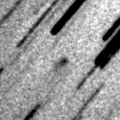
|
Now it is 18.6 mag (May 14, Michael Jager). In the Northern Hemisphere, it stays observable at 18 mag for a long time from 2021 to 2022. It is not observable in the Southern Hemisphere.
Date(TT) R.A. (2000) Decl. Delta r Elong. m1 Best Time(A, h)
June 5 17 11.43 56 6.2 6.815 7.084 101 17.9 0:19 (180, 69)
June 12 17 0.81 56 21.4 6.831 7.085 100 17.9 23:35 (180, 69)
|

|
Now it is 18.6 mag (Apr. 4, Michael Jager). Although it is around the aphelion, it is much brighter than originally predicted.
Date(TT) R.A. (2000) Decl. Delta r Elong. m1 Best Time(A, h)
June 5 10 45.53 9 37.8 5.423 5.428 84 18.8 20:55 ( 70, 41)
June 12 10 47.57 9 16.9 5.534 5.430 78 18.9 21:00 ( 76, 34)
|
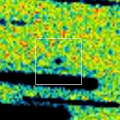
|
It was expected to brighten up to 13 mag from spring to summer. But actually, it is extremely faint as 19.0 mag (Mar. 22, A. C. Gilmore, P. M. Kilmartin). In the Southern Hemisphere, it stays observable in good condition for a long time. In the Northern Hemisphere, it is not observable until late August.
Date(TT) R.A. (2000) Decl. Delta r Elong. m1 Best Time(A, h)
June 5 3 12.71 -41 34.1 1.593 1.536 68 18.8 3:01 (300,-36)
June 12 3 44.09 -39 19.6 1.631 1.538 66 18.9 2:59 (297,-36)
|
|
![]()
 C/2018 N2 ( ASASSN )
C/2018 N2 ( ASASSN ) C/2020 H6 ( ATLAS )
C/2020 H6 ( ATLAS ) C/2020 Y2 ( ATLAS )
C/2020 Y2 ( ATLAS ) C/2019 K7 ( Smith )
C/2019 K7 ( Smith ) C/2017 T2 ( PanSTARRS )
C/2017 T2 ( PanSTARRS ) 67P/Churyumov-Gerasimenko
67P/Churyumov-Gerasimenko 17P/Holmes
17P/Holmes C/2019 U5 ( PanSTARRS )
C/2019 U5 ( PanSTARRS ) C/2019 O3 ( Palomar )
C/2019 O3 ( Palomar ) C/2020 O2 ( Amaral )
C/2020 O2 ( Amaral ) C/2019 T3 ( ATLAS )
C/2019 T3 ( ATLAS ) 106P/Schuster
106P/Schuster C/2021 K1 ( ATLAS )
C/2021 K1 ( ATLAS ) C/2017 Y2 ( PanSTARRS )
C/2017 Y2 ( PanSTARRS ) C/2021 A1 ( Leonard )
C/2021 A1 ( Leonard ) C/2020 S3 ( Erasmus )
C/2020 S3 ( Erasmus ) 284P/McNaught
284P/McNaught C/2020 V2 ( ZTF )
C/2020 V2 ( ZTF ) 57P/du Toit-Neujmin-Delporte
57P/du Toit-Neujmin-Delporte 6P/d'Arrest
6P/d'Arrest C/2020 R7 ( ATLAS )
C/2020 R7 ( ATLAS ) C/2020 S8 ( Lemmon )
C/2020 S8 ( Lemmon ) C/2017 U7 ( PanSTARRS )
C/2017 U7 ( PanSTARRS ) 413P/2020 W4 ( Larson )
413P/2020 W4 ( Larson ) C/2021 D2 ( ZTF )
C/2021 D2 ( ZTF ) P/2014 W12 ( Gibbs )
P/2014 W12 ( Gibbs ) 22P/Kopff
22P/Kopff C/2020 K1 ( PanSTARRS )
C/2020 K1 ( PanSTARRS ) C/2020 F2 ( ATLAS )
C/2020 F2 ( ATLAS ) 193P/LINEAR-NEAT
193P/LINEAR-NEAT C/2020 F7 ( Lemmon )
C/2020 F7 ( Lemmon ) 108P/Ciffreo
108P/Ciffreo C/2020 T4 ( PanSTARRS )
C/2020 T4 ( PanSTARRS ) C/2021 E3 ( ZTF )
C/2021 E3 ( ZTF ) 152P/Helin-Lawrence
152P/Helin-Lawrence C/2017 B3 ( LINEAR )
C/2017 B3 ( LINEAR ) 99P/Kowal 1
99P/Kowal 1 C/2019 C1 ( ATLAS )
C/2019 C1 ( ATLAS ) C/2016 Q2 ( PanSTARRS )
C/2016 Q2 ( PanSTARRS ) 47P/Ashbrook-Jackson
47P/Ashbrook-Jackson C/2020 K5 ( PanSTARRS )
C/2020 K5 ( PanSTARRS )![]()




























































